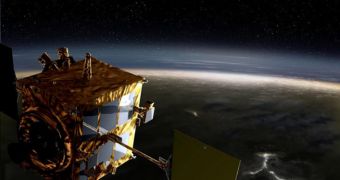The preliminary results of Japanese investigations into the reasons why the Akatsuki space probe failed to insert properly into Venusian orbit show that a faulty valve in one of the spacecraft's engine was most likely responsible.
The probe – aptly named the first weather satellite to be deployed on another planet – was supposed to decelerate from its cosmic journey, and get captured into orbit around Venus on December 6.
However, mission controllers reported shortly afterwards that Akatsuki had overshot its target, meaning that it failed to decelerate sufficiently to allow itself to get captured.
Calculations based on the path the probe is currently on suggest that another orbital insertion attempt may be carried out in late 2016 to early 2017, depending on various circumstances.
This is the second time that a Japanese orbiter heading for another planet failed, following the Nozomi mission disaster. That probe overshot Mars on December 14, 2003, and has been in a 2-year heliocentric orbit ever since.
According to an official report from the Japan Aerospace Exploration Agency (JAXA), quoted by the newspaper Daily Yomiuri, it would appear that a critical valve in Akatsuki's fuel pressure system malfunctioned during the failed orbital insertion attempt.
The new report was received by members of the Space Activities Commission, which was formed by the Japanese Education, Culture, Sports, Science and Technology Ministry.
JAXA now plans “to further investigate why the valve did not open, and how much damage was caused to Akatsuki’s thruster nozzle, by conducting tests that also will indicate whether the probe will be able to go into orbit around Venus when it comes near the planet six years from now.”
Because of the nature of the glitch, the spacecraft itself might have been damaged, and JAXA experts want to establish their exact extent. Based on those findings, the team will decide whether to try for a new orbital insertion attempt, Universe Today reports.
The spacecraft launched on May 20 aboard a H-2A delivery system, together with the IKAROS solar sail demonstrator. The latter was successful in showing that the power of sunlight can be harnessed for space travel.
Among the mission's primary objectives, experts included the discovery and analysis of lightnings and active volcanoes, as well as studies of the planet's clouds. Recently, it was determined that the Venusian sulfur cycle is not as well understood as experts liked to think.
Another one of the greatest mysteries related to the Venusian atmosphere is the presence of lightning in its clouds, given that most of the “air” there is made up of sulfuric acid and other similar compounds.
Understanding the Venusian “super-rotation,” the phenomenon that causes the formation of powerful winds in the atmosphere, was also one of the main topic of study.
This process drives around clouds at speeds of over 360 kilometers per hour, or 220 miles per hour. This means that the atmosphere spins about 60 times faster than Venus itself does.

 14 DAY TRIAL //
14 DAY TRIAL //